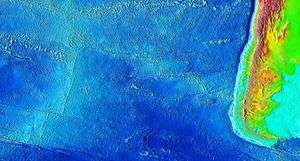Tobífera Formation
| Tobífera Formation Stratigraphic range: Upper Jurassic | |
|---|---|
| Type | Geological formation |
| Sub-units | Basal Clastic Complex |
| Underlies | Zapata Formation |
| Overlies |
Tierra del Fuego Igneous and Metamorphic Complex Cordillera Darwin Metamorphic Complex |
| Lithology | |
| Primary | Silicic pyroclastic rocks (including tuff) |
| Other | Black shale, silicic intrusions, conglomerate, sandstone |
| Location | |
| Region | Magallanes y la Antártica Chilena Region |
| Country | Chile |
Tobífera Formation (Spanish: Formación Tobífera) is a volcano-sedimentary formation of Upper Jurassic age. The formation is located in Magallanes Region in southern Patagonia and Tierra del Fuego. The bulk of the formation originates from silicic pyroclastic material during a period of bimodal volcanism in Rocas Verdes Basin, a rift basin.[1] The Tobífera Formation is grouped together with other formations of similar age in Patagonia in the Chon Aike Province an extraordinarily large province of silicic volcanism.[2] Except for some western and southern exposures most of the formation is burried and known only from boreholes in Magallanes Basin. The formation is equivalent to El Quemado and Ibañez formations.[2] Tobífera Formation has a up to 80 m thick Basal Clastic Complex, a sub-unit made up of conglomerate and sandstone. Tobífera Formation unconformably overlies metamorphic and igneous basement complexes of Cambrian age.[1][3]
Deformation and metamorphism
Much of the formation is folded and faulted as consequence of the Andean orogeny.[1] At Última Esperanza Province the formation metamorphosed first under Greenschist facies and then under prehnite-pumpellyite facies conditions.[4] Some rhyolites of Tobífera Formation were incorporated into Cordillera Darwin Metamorphic Complex. The incorporation of part of Tobífera Formation in the metamorphic complex was accompanied by deformation and metamorphism and occurred in the context of the Andean orogeny in the Cretaceous.[3]
References
- 1 2 3 Fildani, Andrea, Romans, B.W., Fosdick, J.C., Crane, W.H., and Hubbard, S.M. (2008). Orogenesis of the Patagonian Andes as reflected by basin evolution in southernmost South America, in Spencer, J.E., and Titley, S.R., eds., Ores and orogenesis: Circum-Pacific tectonics, geologic evolution, and ore deposits: Arizona Geological Society Digest 22: 259-268.
- 1 2 Pankhurst, R.J., Riley, T.R., Fanning, C.M., & Kelley, S.P. (2000). Episodic silicic volcanism in Patagonia and the Antarctic Peninsula: chronology of magmatism associated with the break-up of Gondwana. Journal of Petrology, 41 (5): 605-625.
- 1 2 Hervé, F.; Fanning, C.M.; Pankhurst, R.J.; Mpodozis, C.; Klepeis, K.; Calderón, M.; Thomson, S.N. (2010). "Detrital zircon SHRIMP U–Pb age study of the Cordillera Darwin Metamorphic Complex of Tierra del Fuego: sedimentary sources and implications for the evolution of the Pacific margin of Gondwana". Journal of the Geological Society, London. 167: 555–568.
- ↑ Galaz, Gonzalo; Hervé, Francisco; Calderón, Mauricio (2005). "Metamorfismo y deformación de la Formación Tobífera en la cordillera Riesco, región de Magallanes, Chile: evidencias para su evolución tectónica". Revista de la Asociación Geológica Argentina (in Spanish). 60 (4): 762–774. Retrieved 26 August 2016.
